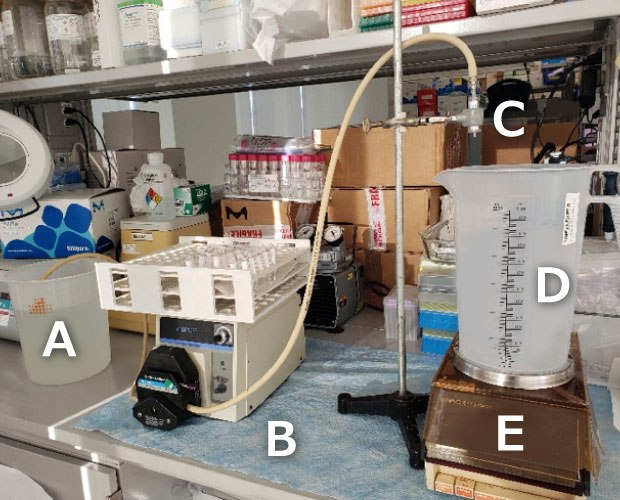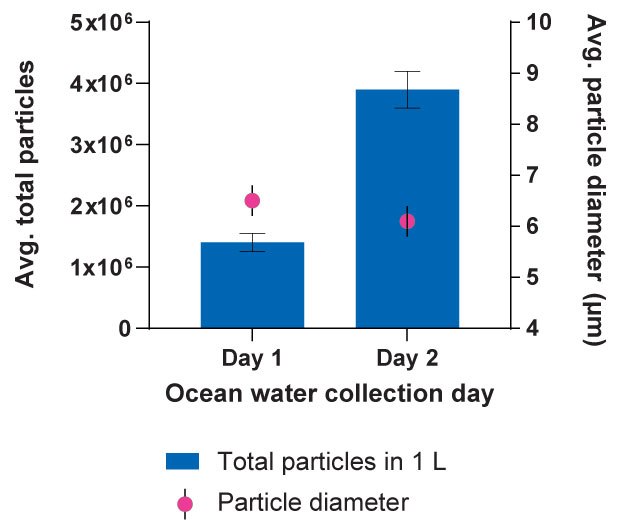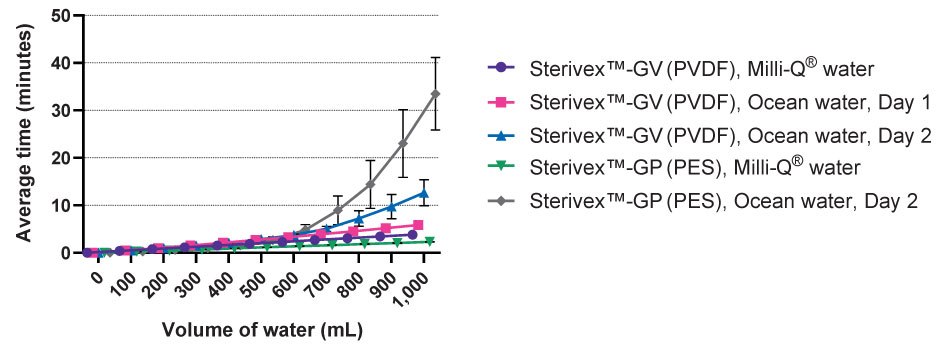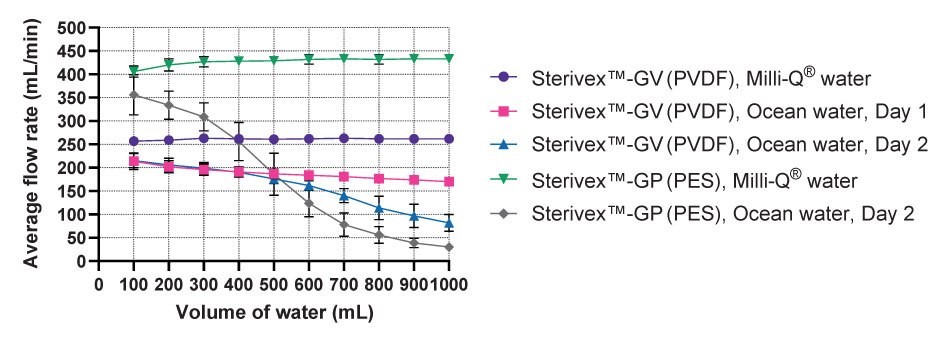The Importance of Filtration in Ocean Water Research and Environmental Testing
Sterile filtration plays a crucial role in oceanographic and environmental research. Here, we demonstrate a general ocean water flow application using Sterivex™ pressure-driven sterile filters for large-volume sample processing.
Section Overview
Filtration in environmental testing and research
Sterile filtration is a vital process in oceanography and environmental research, particularly for the collection and analysis of water samples stemming from oceans, rivers, and lakes. The volume of ocean water required is often determined by specific research parameters and the sensitivity of the analytical methods employed. Many times, volumes ranging from 1 to 2 liters (L) are filtered to remove solids and collect microorganisms, plankton, or other components of interest. The filtered liquid, or “filtrate,” can be collected and retained into any suitable container. A common workflow for sample processing is outlined in Figure 1.

Figure 1.Application of sterile filtration in environmental research. A) Input sample, B) Peristaltic pump with tubing, C) Sterivex™ filter, D) Retentate collection, E) Filtrate collection, F-G) Collection container on balance, H) Timer.
Our innovative, compact, capsule-type Sterivex™ pressure-driven sterile filters have been developed to meet the unique demands of oceanographic and environmental research. These capsules are designed with a vent to expel capsule air and a large working surface area (10 cm2) to accommodate filtration volumes up to 1 - 2 L, depending on the type of filter used in the device. The Sterivex™-GP filter unit containing 0.22 µm polyethersulfone (PES) Millipore Express® PLUS membranes can process up to 2 L, while the Sterivex™-GV and Sterivex™-HV filter units containing 0.22 µm and 0.45 µm Durapore® polyvinylidene fluoride (PVDF) membranes, respectively, have a 1 L capacity. For clarification, the Sterivex™-HV (0.45 µm PVDF membrane) filter unit can be used. Each device captures solids onto the filter within the liquid inside the capsule (~2 mL) and can be capped with common Luer fittings and stored until further analysis.
The importance of filtration in these research solutions cannot be overstated.
Isolating Microorganisms and Particles
Our Sterivex™ pressure-driven filters (combined with a peristaltic pump) enable researchers to isolate and collect microorganisms, plankton, and particles of interest from ocean, river, and other sources of water. This is essential for studying marine biodiversity,1,2 understanding ecological dynamics and communities, and assessing marine life using 16S rRNA metabarcoding.3
Pollutant Analysis
Filtration plays a crucial role in the analysis of pollutants and contaminants in various types of water, including ocean water. Our Sterivex™ pressure-driven filter units facilitate the extraction and concentration of pollutants, microplastics (diameter<5 mm),4 and other substances on the filter’s surface. These contaminants are commonly measured in environmental monitoring and pollution studies.5
Environmental and Ecological Studies
By filtering water samples, researchers can obtain valuable insights into the composition and quality of many types of water. This is instrumental in assessing the health of marine ecosystems, studying nutrient cycles, capturing environmental DNA (eDNA),6 and investigating the effects of contaminants such as microplastics on the environment.
Research Efficiency
Sterivex™ pressure-driven filtration devices offer a practical and efficient solution for processing larger volumes of water samples. Researchers can streamline their sampling processes, maximize data collection, and achieve more accurate and reliable results. Peristaltic pumps provide precise control over flow rates and ensure gentle handling of samples, making them an ideal complement to filtration.
Sterivex™ filter units work with syringes, peristaltic pumps, or pressure vessels, eliminating the risk of contamination associated with decanting or pipetting. These devices are suitable for filtering volumes ranging from 100 mL to 2 L at a maximum rating of 3.1 bar (45 psi), allowing researchers to filter directly into virtually any storage container. They are available with a selection of high-performance filters, providing flexibility and convenience in research applications. Additionally, compatibility with other filtration systems can be achieved simply by choosing the tubing and couplers needed for connection. The minimal and robust design of Sterivex™ filter units allows for quick modifications with ease, offering flexibility for sampling in the field or laboratory for controlled laboratory experiments, local transport and land-based collection, and field-based collection waterfront on a research vessel.
Filtration of large volume samples using Sterivex™ filters
To simulate a researcher’s ocean water filtration process, bulk ocean water was collected twice at surface depth from the shoreline in Gloucester, MA (USA) and transported to the lab for filtering. Visually, sand, seaweed, and plastics were observed in the starting material. A variable speed peristaltic pump (setting 4 of 10) with appropriate tubing fitted with a male Luer lock fitting was used to perform filtration of 1 L of water via connection to the Female Luer-Lok® inlet of the 0.22 µm Sterivex™-GV (PVDF membrane) or Sterivex™-GP (PES membrane) filter. The Sterivex™ filter unit was positioned vertically with the vent surface up using a supported ring stand to allow proper air removal during filtration. Cold ocean water (13°C to 17°C [55°F to 63 °F]) and room temperature Milli-Q® ultrapure water control (24.1°C [75°F]) were processed. Cumulative filtrates were collected over time and measured using a balance until 1 L of filtrate was obtained (Figure 2). To verify particle presence, input ocean water was measured for particles ranging from 4 µm to 20 µm using the Scepter™ 3.0 automated cell counter fitted with 40 µm sensors. Note: Milli-Q® water control does not have enough conductivity to be measured using the Scepter™ 3.0 device.

Figure 2.Test set-up. 1 L of input water A) was pumped through tubing B) connected to a Sterivex™ pressure-driven filter unit C) held in place in a vertical position using a ring stand. Cumulative filtration volumes were measured over time in a beaker D) using a E) top loading balance.
Impact of filtration of ocean water samples using Sterivex™ filters
After filtering ocean water, both the 0.22 µm Sterivex™-GV (PVDF) and the Sterivex™-GP (PES) filter surfaces visually appeared brown and particle laden (Figure 3). Ocean water collected on Day 1 did not have the same darkened buildup/intensity on the filter surface as ocean water collected on Day 2, indicating more particles in the same volume were filtered on Day 2. Ultrapure water samples presented no discoloration after 1 L filtration. Higher particle content was confirmed in the undiluted, starting Day 2 ocean water sample by measurement using a Scepter™ 3.0 automated cell counter fitted with 40 µm sensors (Figure 4).

Figure 3.Filters were imaged after filtration of 1 L of sample. A) Day 1 ocean water (right: 1-11 to 1-13, 2-11 to 2-13) and ultrapure Milli-Q® water (left: 1-10, 2-10) were filtered using 0.22 µm Sterivex™-GV (PVDF) filters. The control sample filters challenged with Milli-Q® ultrapure water showed no discoloration, particles, or debris and remained clean and white after filtering. In contrast, the filters challenged with ocean water exhibited brown deposits with debris and particles apparent on the filter surface. B) Day 2 ocean water was filtered using a 0.22 µm Sterivex™-GV (PVDF) filter (left). An unused filter was imaged for comparison (right). Darker, more numerous deposits were observed on the filter surface using Day 2 ocean water samples compared to Day 1 ocean water samples, indicating a higher particle load retained on the filter surface. No discoloration was observed on the unused filter. C) Day 2 ocean water was filtered using a 0.22 µm Sterivex™-GP (PES) filter. Filter units challenged with ultrapure Milli-Q® water (left: GP1) remained clean and clear, while the ocean water processed samples (right: GP15) had a noticeable buildup of particles on the filter surface.

Figure 4.Two collection days of ocean water were measured using the Scepter™ 3.0 automated cell counter fitted with 40 µm sensors. Samples were measured in triplicate with error bars noted for total number of particles and particle diameter. The total particle counts in 1 L samples were 1.4 x 106 for ocean water collected on Day 1 and 3.9 x 106 for ocean water collected on Day 2, with similar average particle diameters between 6.1 - 6.5 µm.
A higher number of particles larger than the filter’s pore size rating can cake onto a filter’s surface and cause flow times to increase, translating to declining flow rates. Cumulative flow results (Figures 5-6) showed that filtration of ocean water was slower than when filtering ultrapure Milli-Q® water, mainly due to particulate content rather than lower water temperature. However, Sterivex™ filters successfully processed the large 1 L volumes consistently despite decreasing flow rates observed starting at ~500 mL. Day 2 ocean water, with higher particulate load compared to Day 1 ocean water, exhibited further reduced flow rates. All flow rates continued to decay with collection volume, indicating varying levels of blockage of the filters. All tested Sterivex™ filters were able to process 1 L volume of ocean water within 45 minutes using a peristaltic pump. Larger volumes were not tested.

Figure 5.Cumulative filtrate volume over time for filtration of 1 L ocean water (Day 1 and Day 2 collections) and 1 L ultrapure Milli-Q® water samples using 0.22 µm Sterivex™-GV (PVDF) and Sterivex™-GP (PES) filters. Low standard deviations across replicates were observed up to 500 mL using peristaltic pump positive pressure processing (refer to error bars). Ultrapure water had the quickest filtration time over the entire volume for both filter types (≤ 3.8 min.). The ocean water flow time increased starting at ~ 500 mL. Flow time continued to increase and become more variable up to the final 1,000 mL volume processed [Day 1 ocean water processed with 0.22 µm Sterivex™-GV (PVDF) filters: 5.9 minutes; Day 2 ocean water processed with 0.22 µm Sterivex™-GV (PVDF) filters: 12.6 minutes; Day 2 ocean water processed with 0.22 µm Sterivex™-GP (PES) filters: 33.5 minutes].

Figure 6.Flow rates were determined using 0.22 µm Sterivex™-GV (PVDF) and Sterivex™-GP (PES) pressure filters for processing ocean water and ultrapure Milli-Q® water. Low standard deviations across replicates were observed using peristaltic pump positive pressure processing (refer to error bars). The ocean water samples eventually fouled both filter types. Sterivex™-GV (PVDF) filters had slower flow rates than Sterivex™-GP (PES) filters. Flow rates decreased and were virtually identical at the 500 mL collection volume point. As larger volumes were introduced, flow rates dropped even further. However, both filters were able to process 1 L volumes of ocean water samples, despite varying levels of particles in the input material.
Sterivex™ filters for processing environmental samples
Sterivex™ pressure-driven filter units, coupled with peristaltic pumps, prove to be an indispensable, compactly designed filtration tool for oceanographic and environmental research, allowing researchers to extract, concentrate, and analyze diverse components of water. Sterivex™ filters enable scientists to unravel the complexities of marine ecosystems and contribute to a more sustainable future.
References
如要继续阅读,请登录或创建帐户。
暂无帐户?